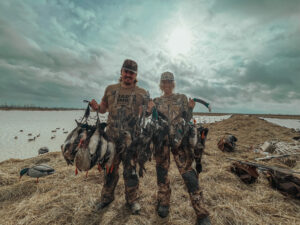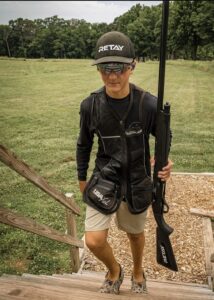
By: TJ Rademacher

I’ve had the opportunity to be on both sides of the client-outfitter relationship. I came out of high school and spent a short time as a big game guide in Montana and Idaho. I got to experience the ups and downs of being in the outfitting business. Since it is a service there is a high amount of pressure to get your client into position for the best opportunity you can. Typically, there are fairly large sums of money changing hands. With that exchange come expectations from the client. This is perfectly acceptable. You should expect the highest amount of effort possible to be put forth by your guide and the outfit to help you get the opportunity for a successful hunt. The key word in that statement is opportunity. The critters you pay good money to chase are not in on this exchange of money.
I don’t care if it’s a laid-back South Texas Teal hunt or grueling pursuit of a big western bull elk, critters do what critters do and they have one thing on their mind. That is survival. They are working for one more day and trying to not get themselves killed. They do not care about what you want. Where they were yesterday, they may not be there today. It’s still hunting at the end of the day. It’s best to remember this when you pay an outfitter for their services. You should not be a push over if you think you are genuinely taken advantage of to be sure but managing your expectations and not letting yourself think that your money alone will buy your success is what I’m driving at. Here are a few things that will help you choose outfitter and end up being more successful. Hopefully, it lends some light on how to be someone that an outfitter looks forward to having back too. This lays out the thought process on how to be successful on a guided hunt.
At the beginning of most hunts there is usually some sort of safety talk from the outfitter or guide. This is a general layout of the expectations, what is acceptable behavior around firearms and other key subjects for the area you are in. I’ve seen and heard about some wild stuff going down. Pay attention to what is expected. You don’t want your guide on edge wondering if they are going to catch a Nosler partition through their ribs because of a client constantly fiddling with safeties and being generally unsafe with a weapon. Follow the rules don’t cut corners and practice the rules of firearms safety.
Most guides are the same as you. They love the outdoors, and they love getting after it and being successful in the field. Most take a huge amount of pride in being the one to count on and help deliver that success. They stay under a constant amount of scrutiny from clients themselves and the managers of the outfit. They want you to be successful because they want to be a successful guide. Be gracious from the start. The amount of logistics and prep to get you where you need to be are huge. In many ways the logistics are what ends up making you successful. Stay humble and treat it like you are a team. It’s okay to ask why you are doing what you are doing sometimes. It shows you are genuinely interested and will typically be appreciated if it comes from that angle. The thing I would tell you to avoid is being the person openly questioning somebody who has likely forgotten more hours in the area you are hunting than you have put in probably anywhere. This is not a good way to form a successful team and may hinder your success greatly. Check your ego at the door and be in the moment there with your guide. They will appreciate your attitude.

Come prepared. When you are researching an outfit to hunt with, you’ll typically see a packing list of some sort. Pay attention to this and either pack or purchase the items you think you’ll need accordingly. If you must purchase something like boots make sure you are wearing them months or at the very least, weeks in advance of your hunt if you are planning on a western big game hunt. I’ve seen new boots smoke clients within a couple days. Don’t do that to yourself.
Along with breaking in your boots or other gear you need to be physically up to the challenge. Don’t be the guy who so horribly misjudged the physical requirements of a hunt that they can’t take advantage of the guides experience due to lack of ability to get to the places they need you to go. This is your responsibility to make sure you have the endurance to do this in advance. It’s hard from the guides perspective to feel a ton of sympathy when you don’t plan ahead.
Actively participate in the hunt from start to end. It is about the experience and your guide can see that. You will always get more from someone when you try and match their efforts or assist them in some way. Don’t be the guy who doesn’t help brush and A-frame or at least offer to set out/ pick up decoys. It’s a small gesture that will help earn mutual respect between both parties and in some cases influence your success. This Is especially true when you are setting up 60-70 dozen silhouettes on a Kansas field hunt where the farmer won’t allow trucks and trailers in the field. It’s all part of it and you need to help roll with the punches to be successful.

Tip. Even if you are not as successful as you had figured. the effort to get you on the best opportunity possible was most likely put forth if you went with a reputable outfitter. Your choice in outfitter is your responsibility. You should seek out a group of people who are honest and hard working. They typically have been in business for a while and have a good track record of keeping their clients happy for the most part. Don’t try to cut corners and go with someone who doesn’t exhibit most of these qualities. Especially the honesty and work ethics part. Your tip is your sign of appreciation to the individual that helped you have the best experience available at that time. You should recognize their efforts by tipping accordingly if they have done their job to the best of their ability. Sometimes you are unsuccessful no matter what happens due to a variety of reasons. A lot of these are beyond anyone’s control. You can have a skunk at peak rut as well as the day of a peak migration.
If you’ve made it this far you’ve seen that a guided hunt is an interactive experience and comes with some simple responsibilities on your part. Accepting These will help you have the best experience you can possibly get access to at that particular point in the season. Plan ahead and book during times that have historically been the most productive for the outfitter in the past. Above all be gracious and positive. Be ready to put in the effort to get you the rest of the way to success. Also remember That this is supposed to be fun. Don’t take things so seriously that you aren’t taking something positive away from the time you are in the field.
Cherish each sunrise. You aren’t guaranteed tomorrows.
T




